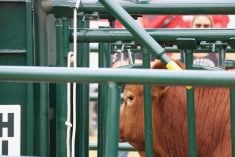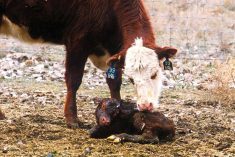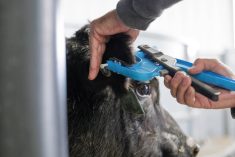By the time the calf hit the ground in the arena of the Royal Manitoba Winter Fair, the spectacle had drawn quite a crowd.
The birth was everything the beef producer would want to avoid — it was a hard pull, the calf contorted into the wrong position. The veterinarian on hand had a hard time repositioning the head or finding the front hoofs. The chains, once the hoofs were found, kept slipping.
Read Also

Mandatory holiday joy a valid struggle
Christmas may not be that jolly for everyone. Farm family coach Kalynn Spain suggests those struggling with over-the-top joy during the holidays instead aim for “fulfilled” or “content.”
Despite the difficulty, Dr. Everett More was calm as he explained each step in the process to the audience, even calling several children watching to assist.
There was no actual risk after all. The calf, and the cow, were fake.
Why it matters: A calving simulator can give future cattle producers experience on what to do when things go wrong, before they face it in the farmyard.
The demonstration was a chance for the Manitoba 4-H Council to show off “Clover,” a life-size calving simulator. Clover’s plastic and rubber body, modelled and painted after a Hereford cow, includes a mock uterus, birthing canal and realistically sized calf model.
The provincial 4-H council officially unveiled Clover during Brandon’s Royal Manitoba Winter Fair at the end of March. The simulator was the highlight of the council’s booth, with regular demonstrations throughout the week-long event.
For many in the audience, it was the first exposure to calving, Manitoba 4-H Council executive director Shannon Carvey said.
“The safe thing about the model is that they can just sort of get in there and help and I think it’s probably just been a great little experience for them… it’s so lifelike,” she said.
The latest tool in the council’s beef programming and ag education tool box, Clover began as a teaching resource for the Western College of Veterinary Medicine. The Manitoba 4-H Council acquired Clover. The model was purchased with help from the Manitoba Beef Producers, Manitoba Ag Days, MBFI, Crop Connect, Co-ops and $5,000 worth of provincial funding.
“This actually is exactly what they use at the veterinary college to teach students how to calve cows,” said More, a retired veterinarian — and the day’s calving demonstrator at the 4-H booth.
Aside from a realistic mimic to calving, without any of the real-world risks in play with live animals, the simulator’s value lies in the ability to set up different scenarios, he noted. Clover could easily simulate birth complications, hard pulls and other essential skills for those veterinary students without the stakes of animal health, and on demand.
It’s a benefit that the Manitoba 4-H Council hopes its own members will now derive.

Carvey said the purchase was actually made prior to the COVID-19 pandemic, but the council was unable to utilize it until now, due to public health measures. The simulator has spent the time at the Manitoba Beef and Forage Initiatives (MBFI), an applied research and ag education site north of Brandon near Brookdale.
On display
Clover will remain at MBFI indefinitely, Carvey said, but unlike those first months, this time Clover will not be idle.
While the simulator will not be hitting the road to visit any 4-H clubs, Carvey noted that veterinarians will be called in to hold workshops at the Brookdale site, using the simulator.
“There’s going to be a couple of different ways we’re going to use her,” she said. “We’re going to be able to use her for our beef kids in the 4-H program to teach about calving and how to get a leg that’s back and how to put the chains on properly, basically be able to pull a calf on their own if they needed to.”
MBFI staff have also expressed interest in using Clover for outreach to the urban population, such as with school groups or other events.
“She would be able to provide an opportunity for those kids to see how a baby calf is born and the life cycle of a cow,” Carvey said. “So she’s going to be a huge educational tool for us.”
The simulator will be a standing feature at MBFI’s Learning Centre, Carvey said. The centre was constructed in 2018 to expand the farm’s capacity for farmer-oriented extension, ag education and public outreach.















